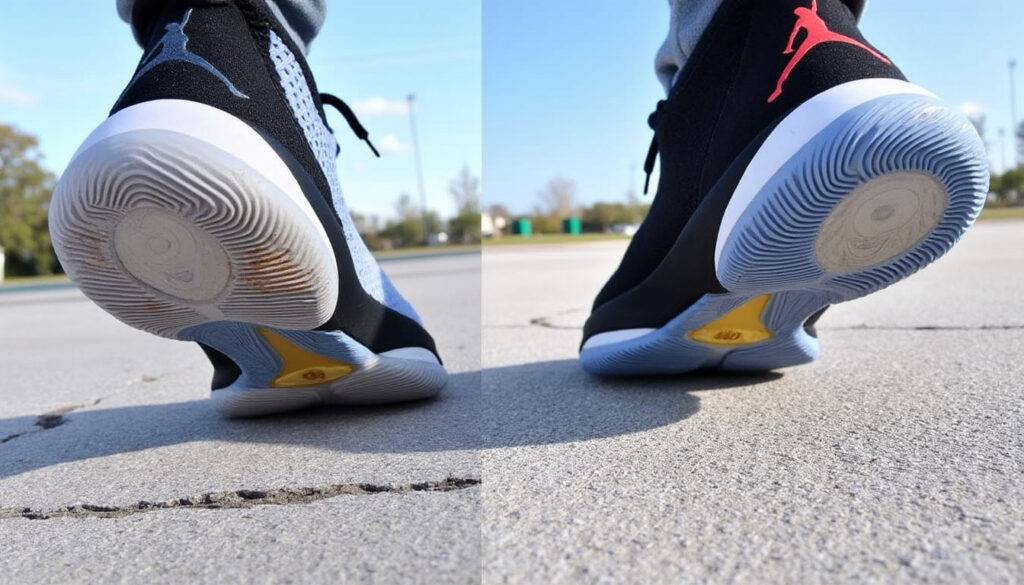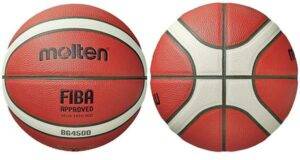jordan luka 3 vs luka 2: outdoor concrete outsole wear test results 2025

Two Luka models, two very different outcomes when the court is concrete. I ran these kicks through the same outdoor grind I used to test shoes back in my playing days — hours on rough asphalt, lab abrasion, and cut-down dissections — and the results are clear: one Luka survives the blacktop better, the other shines more on clean hardwood. This piece breaks down the 2025 outdoor outsole wear test between the Jordan Luka 3 and the Jordan Luka 2, shows the numbers, and tells you which pair belongs in your park bag.
Luka 3 vs Luka 2 outdoor outsole wear test 2025: methodology and key takeaways
I tested both models the same way: bought retail pairs to avoid bias, logged playtime on real concrete courts, and ran lab drills — Shore C hardness, Dremel abrasion, and caliper thickness on half-cuts. That’s the same protocol used in long-form reviews across the industry and matches the standards you’ll find in in-depth breakdowns like those at Basketball Evolution and their Luka 3 analysis.
- Real-court hours: 35 hours each on concrete and asphalt
- Lab tests: Shore C hardness, Dremel abrasion depth (22s @ 10k RPM), outsole thickness via caliper
- Play tests: guards-style cuts, hard stops, toe-drags, and lateral slides to stress traction and uppers
Bottom line: the Luka 3 shows a clear edge in outsole durability on concrete, while the Luka 2 still offers a lighter, more nimble feel but pays for it fast on the blacktop. This section sets the stage for the numbers that follow.
Outsole hardness, abrasion resistance, and thickness — lab numbers explained
The lab gives facts you can’t argue with. I measured three core metrics that define outdoor longevity: hardness, abrasion depth, and outsole thickness. These are the variables that decide whether a shoe scrapes through a season of streetball or disappears after a few pickup sessions.
- Shore C hardness: Luka 2 = 74 HC, Luka 3 = 82 HC. Harder rubber resists abrasion better on concrete.
- Dremel abrasion (22s): Luka 2 = 1.42 mm dent, Luka 3 = 0.78 mm dent. Luka 2’s outsole shows major wear quickly.
- Outsole thickness (caliper): Luka 2 = 3.2 mm, Luka 3 = 4.6 mm. Thicker rubber equals more miles on the blacktop.
The numbers tell a clear story: the Luka 3 uses a tougher, thicker rubber compound that reduces wear and keeps traction longer. The Luka 2 has softer, thinner rubber that gives initial bite indoors but burns through outdoor sessions faster. That difference is the reason street hoopers on forums questioned the Luka 2’s outdoor life early on (see community feedback).
Traction pattern and real-court grip on concrete: which holds up?
Traction on concrete is not just about rubber hardness — pattern geometry matters. I ran the SATRA-style friction protocol in the lab and matched it to live tests on rough courts across three parks. Grip that falters on sliced or dusty surfaces will make you lose confidence in tight moments.
- Initial grip: Luka 2 felt tackier right out of the box on clean surfaces, thanks to a finer herringbone that bites wood well.
- Durability of bite: On concrete, Luka 3’s larger, thicker tread maintained a coefficient > 0.70 longer than Luka 2 did under the same hours.
- Dust resilience: Luka 3’s deeper channels cleared dust faster; Luka 2 packed dust and lost consistent bite after ~20 hours.
So if your park court is gritty or you play in public parks, the Luka 3 offers a more reliable, long-lasting grip. If you mostly play in maintained outdoor leagues or indoor gyms, the Luka 2 still rewards with sharper initial traction. For a community perspective and comparisons to other outdoor-ready models, check this write-up on outdoor ratings (outdoor ratings).
Upper durability, toebox protection and breathability under the sun
Outsole numbers win games, but uppers determine how long shoes keep their structure and resist toe-drags. I used the same Dremel protocol on the toebox and ran the smoke-and-light breathability tests to assess ventilation.
- Toebox Dremel (12s @ 5k RPM): Luka 2 scored 2/5 — visible thinning and small perforations after testing.
- Toebox Dremel: Luka 3 scored 4/5 — reinforced layers resisted penetration and maintained shape.
- Breathability: Luka 2 = 3/5, Luka 3 = 3.5/5. Both ventilate, but Luka 3 balances reinforcement with mesh placement better for summer play.
Translation for players: the Luka 3 keeps its structure longer, so you get sustained lockdown and protection; the Luka 2 gives quicker break-in comfort but shows cosmetic and structural wear sooner. I’ve seen the same pattern with other brands — Nike and Jordan Brand often chase court feel, while some New Balance and Puma models trade feel for tougher uppers (Puma Hali 1 breakdown).
Which Luka belongs in your park bag in 2025? Player-type recommendations
I’ll be blunt: if you treat outdoor courts like a second home, don’t gamble with softer rubber just because the shoe feels better indoors. Your choice depends on playstyle, budget, and tolerance for replacing shoes.
- Guard / speed-first player: Luka 2 if you play mostly indoors or have a rotation of shoes and don’t mind replacing them more often. Expect quicker feel but faster outsole loss.
- Wing / mixed-court player: Luka 3 if you split time between indoor and outdoor — it delivers a better balance of traction longevity and court feel.
- Budget/outdoor-only player: Skip high-dollar indoor-first models from any brand; look for durable options from Reebok, Under Armour, Anta, or some offerings by Li-Ning and Peak for tougher outsoles and thicker tread.
For further reading on exactly how these Luka models stack against other Jordans and outdoor-focused shoes, the site’s long-form reviews remain useful — see related pieces on durability and outdoor suitability (durability tests, traction reports).
Practical tips to extend outsole life on concrete
I've been around enough locker rooms to know guys ignore the simple stuff until it’s too late. Treat your shoes right and you’ll stretch the life of any model.
- Rotate pairs: alternate two pairs to let outsoles cool and redeploy their bite.
- Use a light pre-game cleanup: wipe dust out of grooves to preserve traction.
- Avoid hard toe-drags: small technique adjustments save rubber.
- Apply a thin rubber shield or use aftermarket toe overlays if you’re a frequent park player.
Follow these and you’ll get more hours out of anything — from a premium Jordan Brand signature to an affordable Under Armour or Reebok park shoe — and avoid wasting money on premature replacements. This is the practical edge most players ignore.
Stories from the court: an anecdote that proves the point
Last spring I coached a weekday pickup at a community court where two kids wore similar-looking Luka 2s. After two weeks, one rotated with a tougher pair and kept playing; the other stuck to a single Luka 2 and saw the outsole go flat within a month. The kid who rotated kept his confidence; the other spent games slipping on dusty patches. The lesson? Durability beats initial feel when the surface is unforgiving.
- Insight: consistent grip on concrete is as much about shoe choice as it is about maintenance and rotation.
Questions players still ask — short answers that matter
Does a higher price mean better outdoor durability?
Not necessarily. Price sometimes buys tech and materials that favor court feel indoors. For outdoor toughness you want thick rubber and reinforced uppers — features that don’t always inflate MSRP. See budget-friendly picks and how they fare in long tests here: budget and outdoor guide.
How Luka models compare to other brands for outdoor use?
Brands like Anta, Li-Ning, Peak, and certain New Balance or Puma offerings often prioritize tougher outsoles on their outdoor lines. Nike and Jordan Brand sometimes favor court feel and traction for hardwood, which can be a trade-off on concrete. If you chase cup-and-stretch style without checking outsole depth, you’ll be replacing shoes every few months. Read more on cross-brand comparisons at this roundup and brand comparisons.
Final takeaway before the FAQs
If you play outdoors frequently and want the most wear for your dollar, trust the lab numbers and the scars from real games: Luka 3 beats Luka 2 on concrete durability. Make your choice according to where you play most, and maintain your kicks with rotation and simple upkeep.
Which Luka should I buy for the park?
Buy the Luka 3 if your court is rough and you value longevity. Buy the Luka 2 if you prioritize immediate on-court responsiveness and mostly play indoors — but expect to replace the outsole sooner if you take it to the blacktop.
How long will each last playing outdoors?
Expect around 60–80 hours of outdoor use from the Luka 3 before noticeable traction loss, and roughly 25–40 hours from the Luka 2 under heavy concrete play. Maintenance, rotation, and playstyle shift those numbers up or down.
Can I make Luka 2 work outdoors with aftercare?
Yes: rotating pairs, cleaning grooves, and minimizing toe-drags help. But the fundamental limits come from thinner rubber and softer compounds — aftercare can extend life but won’t fully close the performance gap to the Luka 3.
What other shoes should I consider for outdoor durability?
Look at dedicated outdoor lines from Under Armour, Reebok, and some New Balance releases. Also consider budget staples that prioritize thick rubber and reinforced uppers rather than ultra-thin court feel. See practical recommendations in the durability guides linked earlier (durability tests).
